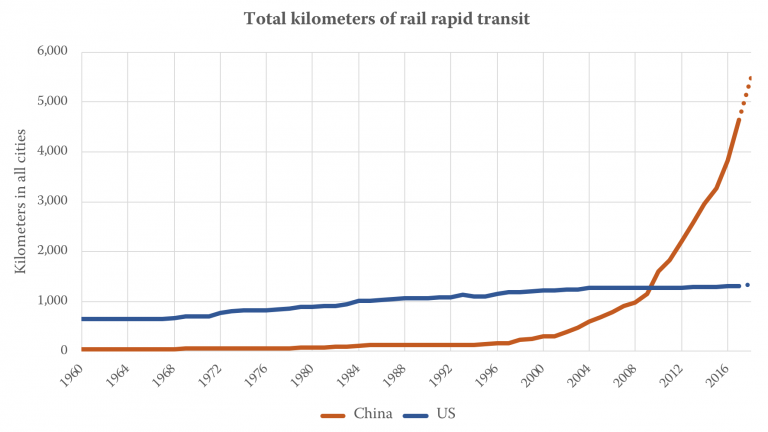In America, we spend tens of billions of dollars on transportation infrastructure each year -- mostly on roads that induce driving and traffic, increase carbon emissions, and claim a shocking number of lives. The nation's political leadership is currently dithering about how to pay for a $200 billion infrastructure package that promises more business-as-usual spending. And the Trump White House is withholding funds for transit expansion projects across the country for ideological reasons.
Meanwhile, China is currently in the midst of the most ambitious subway construction boom the world has ever seen. The implications for the future of the country -- as well as the global climate -- are huge. Yonah Freemark at the Transport Politic takes a look at the dizzying pace of rapid transit expansion in dozens of Chinese cities:
A country largely bereft of metros in the 1990s now has more than 5,000 kilometers of metro lines, more than four times the U.S. figure, which has increased very slowly since the 1960s. 25 Chinese cities now have systems, and the number is rising every year.
Of the 12 largest metro networks in the world by length, seven are now in China. As of December 2017, Guangzhou’s metro passed New York’s Subway in length, and Beijing and Shanghai have by far the longest systems.
Some estimates suggest that Chinese cities will have more than 10,000 kilometers of metro lines by 2020. That’s in addition to the almost 1,000 kilometers of bus rapid transit, hundreds of kilometers of tramways, and massive commuter rail systems that have been built in cities around the country -- not to mention the enormous high-speed rail network that has been constructed since 2007.
This investment in metro capacity has been met by a popular shift in how people get around. Current Chinese metro lines collectively carry about twice as many riders as the entire American public transportation network, buses, trains, and all.
The “riding habit” -- the frequency of transit use per capita -- has risen quickly in city after city. Guangzhou and Beijing now have greater use of their systems than any American city except for New York, with the average resident there taking 189 and 167 rides per year, respectively, compared to 230 per year in Gotham. Beijing and Shanghai systems now each carry more than ten million daily riders, the two highest figures in the world. And they have both doubled their ridership since 2010. It seems likely that the other cities following their path in line construction will eventually follow their lead in ridership, too.
Metro construction in China is largely the product of a massive central government investment. Between 2010 and 2015, the nation spent the equivalent of $189 billion on such lines, and between 2016 and 2020, it is expected to spend between $262 and $308 billion more. The U.S. government dedicates about $2.3 billion per year in total for all transit projects, so less than one-fifteenth of the Chinese investment.
Obviously, one reason China is able to pull off a massive infrastructure initiative like this is its top-down one-party dictatorship. But messy American democracy has managed to build large-scale public works before. Today, however, austerity and anti-urbanism define federal policy here, and high costs inhibit what cities can do on their own. In the "act of comparison" to China, Freemark says, "the illness of American planning is made apparent."
More recommended reading today: The Urban Edge explains how millennial migration has reshaped downtown Phoenix and Houston, and why those sustaining that growth might be a challenge. And the Tampa Bay Times says bus rapid transit could be the answer to the region's mobility problems -- but not if it gets watered down.





